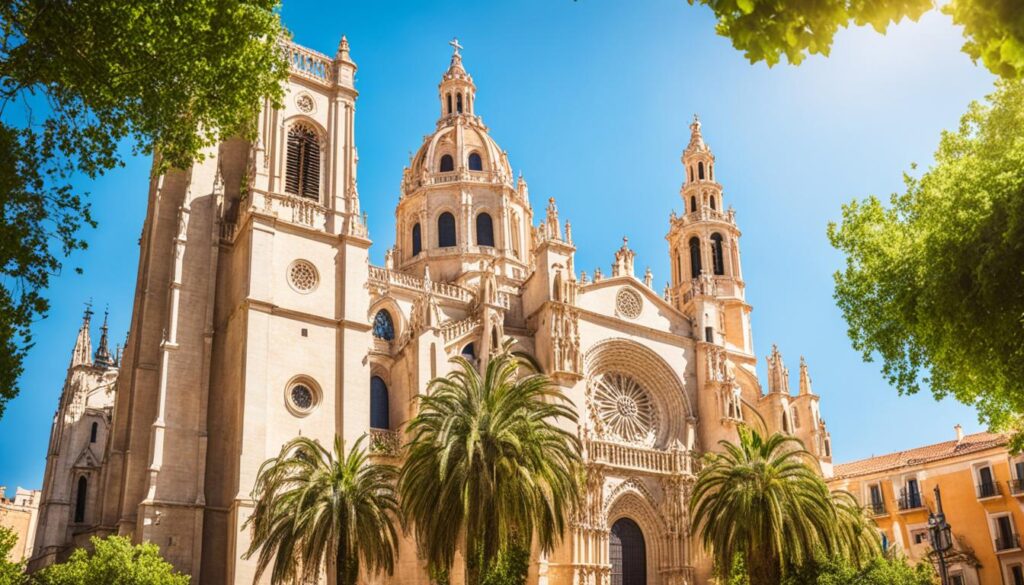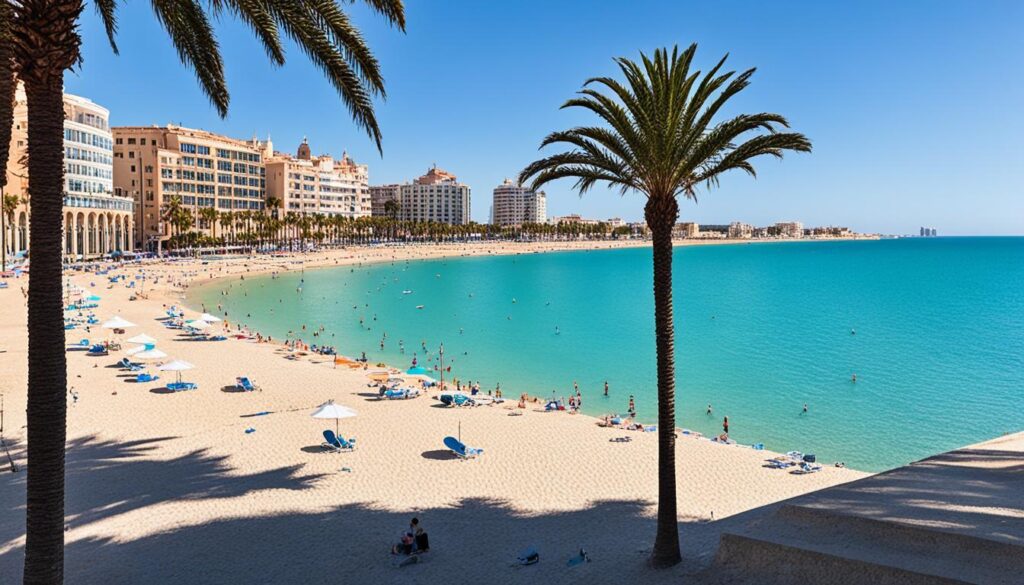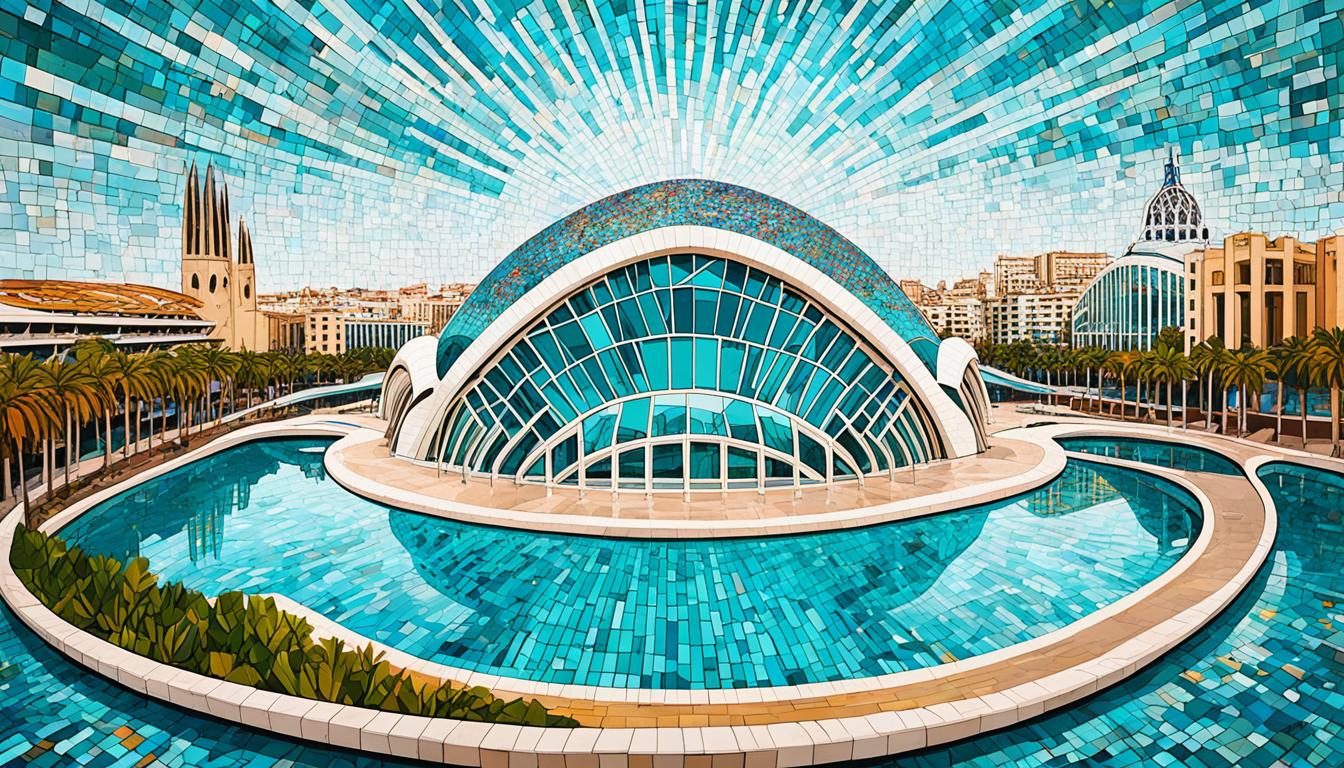Discover Valencia’s hidden gems with insider travel tips. From stunning beaches to vibrant cuisine, explore the best of Spain’s third-largest city. Originally a Roman colony and once the capital of Spain, Valencia is the birthplace of paella (and is allegedly home to the Holy Grail). With three UNESCO Sites, one of the largest markets in Europe, and the massive City of Arts and Science complex, Valencia is well worth a visit. This guide will help you plan your trip and make the most of your time in this beautiful city.
Key Takeaways
- Discover Valencia’s hidden gems and top attractions, from the City of Arts and Sciences to the lively La Tomatina Festival.
- Explore the city’s outdoor adventures, including the Albufera Nature Reserve and the scenic Turia Gardens.
- Immerse yourself in Valencia’s rich cultural heritage, visiting the stunning Valencia Cathedral and the vibrant Central Market.
- Indulge in the city’s culinary delights, from the famous paella to the local tapas scene.
- Plan your visit around the best time, with May/June highlighted as the ideal period due to near-perfect temperatures.
Introduction
Valencia is a city on Spain’s eastern coast, blending old and new. It was a Roman colony, then Spain’s capital, and now it’s the third-largest city. It’s famous for its beautiful architecture, lively food scene, and stunning beaches. This makes it a top spot for travelers.
Why Visit Valencia?
Valencia has a mild climate perfect for visiting any time of the year. It’s packed with cultural spots, from the modern City of Arts and Sciences to the historic Old Town. You can see amazing sites, enjoy nature, try the famous paella, and join in on festivals all year.
It’s also a great spot for day trips to places like the Sagunto Roman Ruins. Whether you like art, history, food, or the outdoors, Valencia has something for everyone.
“Valencia offers a unique blend of old and new, with stunning architecture, a vibrant culinary scene, and beautiful beaches.”
Valencia’s culture is a big draw. You can explore the City of Arts and Sciences or wander through the historic Old Town. Don’t miss the La Tomatina festival in Buñol, where thousands join a huge tomato fight.
The city’s mild weather and beautiful coast are perfect for outdoor fun. The Albufera Nature Reserve and Turia Gardens are great for hiking and birdwatching.
Food lovers will adore Valencia’s food scene, especially the paella. The Central Market is full of fresh produce and local treats, showing off Valencian culture.
If you’re thinking of visiting Valencia or just want to learn more, this guide is for you. It’s full of reasons to visit and explore Spain’s third-largest city.
Top Attractions in Valencia
Valencia is a city full of history, culture, and stunning architecture. It has many attractions that visitors must see. From the modern City of Arts and Sciences to the fun La Tomatina Festival and the beautiful Old Town, there’s a lot to explore.
City of Arts and Sciences
The City of Arts and Sciences is a key spot in Valencia. It was created by famous architect Santiago Calatrava. This place has an IMAX theater, planetarium, science museum, aquarium, and an opera house.
It’s perfect for those who love culture and architecture. Visitors can enjoy the modern buildings and beautiful gardens. Every year, over 4 million people visit, making it one of Spain’s 12 Treasures.
La Tomatina Festival
Valencia hosts the famous La Tomatina Festival. It happens every year on the last Wednesday of August in Buñol. Thousands of people come to throw tomatoes at each other in a fun fight.
This tradition started in 1945 and now draws people from all over the world. After the fight, there’s music, sangria, and more fun. Tickets for La Tomatina sell out fast, so book early.
Historic Old Town
The historic Old Town of Valencia is a must-see. It’s over 2,000 years old and has the famous Plaza de la Virgen and the Valencia Cathedral. The streets of Barrio del Carmen show off Spanish-style buildings with big doors and beautiful windows.
This area is one of Europe’s biggest historic centers. It’s perfect for a leisurely walk, enjoying a cafe, and taking in the history and culture.
Outdoor Adventures in Valencia
Valencia’s natural wonders call to those who love the outdoors. Just 15 miles from the city center is the Albufera Nature Reserve. This place is a peaceful wetland full of different animals. It has the biggest freshwater lagoon in Spain, surrounded by beautiful rice fields and is a home for over 300 bird species.
Visitors can walk on many trails, watch birds, or take a calm boat tour on the lagoon. This tour shows the area’s deep farming history.
The Turia Gardens is another green spot in Valencia. It’s a big park that goes through the city where the old Turia River used to flow. This park is over 9 kilometers long and is a quiet place away from the busy city. It has green lawns, places for kids to play, sports fields, and beautiful sculptures.
People can walk or bike through the gardens. They’ll see famous places like the City of Arts and Sciences and the Central Market.
“The Albufera Nature Reserve is a must-visit for nature lovers, while the Turia Gardens provide a serene escape right in the heart of Valencia.”
Cultural Experiences
Valencia is a city full of culture. It’s home to the famous Valencia Cathedral and the Central Market.
Valencia Cathedral
The Valencia Cathedral is a stunning landmark from the 13th century. It was built where a mosque once stood. The cathedral shows off a mix of Gothic, Baroque, and Neoclassical styles.
Inside, you’ll find beautiful stone carvings and medieval frescoes. There’s also the Holy Chalice, which might be the real Holy Grail. To see the city from above, climb the Miguelete tower.
This cathedral has a history of over 700 years. It’s a key spot for learning about Valencia’s culture and faith.
Central Market
The Mercado Central is another key cultural spot in Valencia. It’s one of Europe’s biggest indoor markets. Built in the 19th century, it’s known for its beautiful Valencian Art Nouveau style.
Today, it’s a lively place with over 1,200 stalls. You can find everything from fresh produce to seafood. It’s a great place to try local foods and feel the city’s vibe.

“The Valencia Cathedral is a must-see for those interested in the city’s rich religious and cultural heritage.”
Culinary Delights
Valencia is the top spot for trying paella, the famous Spanish rice dish. The traditional Valencian paella has rabbit, snails, and green beans cooked in a big pan. Even with many new versions, the classic paella is still a key part of valencian cuisine.
Paella is found on menus all over the city, from beachfront eateries to cozy tapas bars. For the best taste, look for places that cook their paella in wood-fired pans. Eating fresh paella by the Mediterranean is a must-do in Valencia.
Paella
Valencia is where the biggest freshwater lagoon in Spain, Albufera, is found. This is where they grow the rice for traditional Paella Valenciana. Ricard Camarena, a Michelin-star chef from Valencia, has helped make the local food scene famous. Don’t miss the Arroz al horno festival in Xativa, a celebration of the traditional dish.
Local Cuisine and Tapas
Valencia is known for more than just paella. It has a lively food scene with many local foods to try. You can enjoy fresh seafood, hearty stews, and more. Tapas, or small plates, are a big deal here, with dishes like cured meats and cheeses.
Places like Sagardi are great for trying different local tastes. For those who prefer vegetarian or vegan food, there are many options too. Valencia has a lot of restaurants that cater to all kinds of diets.
“Valencia is the ultimate destination for sampling the iconic Spanish rice dish, paella.”
Beaches of Valencia
Valencia isn’t as famous for its beaches as the Costa Blanca nearby. Yet, it has a lovely coastline that offers a break from city life. The top beach is Malvarrosa Beach, known for its long promenade with bars and restaurants. Other favorites include Las Arenas, Patacona, and El Saler, nestled in the Albufera Nature Reserve.
If you want a quieter spot, try El Puig Beach. It’s a bit away from the city but has pebble and sand shores. No matter which beach in Valencia, Spain you pick, you’ll enjoy the Mediterranean sun and a break from the city.
| Beach | Accessibility |
|---|---|
| Playa de la Malvarrosa | Accessible by Bus 31 in 25-30 minutes |
| Playa de las Arenas | Accessible by Bus 32 in 20-25 minutes |
| El Saler Beach | Accessible by Bus 25 in 40 minutes |
| Playa de Pinedo | Accessible by Bus 14 or 15 in 30-35 minutes |
| Playa de l’Arbre del Gos | Accessible by Bus 25 in 45 minutes |
| Playa de la Garrofera | Accessible by Bus 25 in 50 minutes |
| Playa de la Devesa | Accessible by Bus 25 in 50 minutes |
| Port Saplaya Beach | Accessible by Bus 112 in 30-35 minutes |
| Playa del Recatí | Accessible by Bus 25 in 40-45 minutes |
| Playa de Cabanyal | Accessible by Buses 1, 2, 19, 31, and 32 in 15-20 minutes |
Valencia’s beaches may not be as famous as some other places in Spain. But they are beautiful and relaxing. Visitors can find the perfect spot to enjoy the sun and the city’s laid-back vibe.

Valencia Spain Travel Tips
When planning a trip to Valencia, Spain, keep these tips in mind. The city is easy to get to by public transport, with the metro a cheap and easy way from the airport to downtown. Renting a bike is also a great idea to see the city and its parks.
For places to stay, check out the SH Ingles hotel or the Caro Boutique Hotel in the city center. The best time to visit is in spring or fall when it’s mild. Don’t forget to learn some Spanish phrases, as not everyone speaks English well.
“Valencia is beginning to show up more on the tourism radar, offering a refreshing lack of crowds compared to other popular Spanish destinations.”
Don’t miss the City of Arts and Sciences, a huge attraction that cost a lot to build. You can also visit the Silk Exchange for just 2 EUR.
Immerse yourself in the local culture at the Mercado Central, a big market in Europe. Or, watch a flamenco show at Cafe del Duende for 12 EUR, including a drink.
The city’s airport has flights to many places in Europe. A 10-trip ticket for public transport costs between 7.60 to 21 EUR, depending on the area. Staying in the city center or near the old town is also affordable.
Top Tips for Visiting Valencia
- Explore the city by bike or on foot to discover hidden gems
- Visit the Mercado Central, one of the biggest markets in Europe
- Catch a flamenco show at Cafe del Duende
- Stay in the city center or near the old town for convenient access
- Plan your trip during the mild spring or fall months
Valencia is perfect for those who love architecture, culture, or just want to enjoy the Mediterranean sun. With these tips, you’re all set for a great trip to this Spanish city.
Festivals and Events
Las Fallas: Valencia’s Explosive Celebration of Spring
The Las Fallas festival in Valencia, Spain, is a big deal. It lasts a month and ends with a big finale in late March. People build huge statues called “fallas” and then burn them down in a big fire show.
This “build and burn” tradition has been around for centuries. Now, it draws over 1 million visitors every year. The festival also has parades, music, and non-stop fun, making it a memorable event.
Some key events during the las fallas festival valencia include:
- Planta de la falla: The construction and installation of the fallas on March 15th.
- Ofrenda Procession: A two-day parade where locals bring flowers to the Virgin Mary on March 17-18.
- La Crema: The dramatic burning of the fallas on March 19th, marking the end of the festival.
What is las fallas is all about fire, music, and community. It’s a unique celebration that shows off Valencia’s culture. Whether you like the big statues or the loud fireworks, this festival will impress you.
“Las Fallas is a celebration of fire, light, and community – a unique cultural experience that showcases the creativity and passion of the Valencian people.”
Day Trips from Valencia
Valencia is full of attractions that will keep you busy. But it’s also a great place to start exploring the area around it. A top day trip is to the coastal town of Sagunto, just 18 miles away. Sagunto has a long history, dating back to Iberian and Roman times. It’s famous for its well-preserved Roman theater and castle ruins.
In Sagunto, you can walk the ancient city walls, visit the history museum, and enjoy views from the castle. The town shows off Roman, Islamic, and Spanish architecture. This mix of styles gives a peek into its complex history. The sagunto roman ruins and what to see in sagunto make it a key spot for history lovers and culture seekers.
Getting to Sagunto from Valencia is easy, with a 30-minute train ride. A round-trip ticket costs only €4.20. Whether you go alone or with a guide, a day in Sagunto will be memorable. It will deepen your knowledge of Spain’s rich history.
“Wandering the ancient streets of Sagunto is like stepping back in time, where the echoes of Roman legions and Moorish conquerors still linger in the air.” – Josephine, travel blogger
Practical Information
Getting Around
Valencia is easy to explore on foot because it’s not too big. But, there’s also a good public transportation system for longer trips. You can use the metro and bus networks for just €1.50 a ticket. Renting a bicycle is another great way to see the city. Taxis are there too, but they cost more, especially from the airport. With some planning, getting around Valencia is easy and stress-free.
Where to Stay
Valencia has many accommodation options for all budgets. For a central location, the SH Ingles hotel is a good choice. It has clean rooms and offers an on-site restaurant and bar. If you want something more upscale and boutique, try the Caro Hotel. It’s in a historic building and has stylish rooms and a free minibar. It’s wise to book your stay early, especially in summer when places fill up fast.
Best Time to Visit
The best time to visit Valencia is in spring (April-May) or fall (September-October). The weather is nice, and there are fewer people around. Summer (June-August) gets very hot and crowded, especially in the peak tourist season. If you want to see the La Tomatina festival, plan your trip for late August. Winter (December-February) is quieter and prices are lower, but some places might be closed. The best time for you depends on what you like and what you want to do.
| Season | Weather | Crowd Levels | Recommended Visits |
|---|---|---|---|
| Spring (April-May) | Mild | Smaller | Recommended |
| Summer (June-August) | Hot | Crowded | Not Recommended |
| Fall (September-October) | Mild | Smaller | Recommended |
| Winter (December-February) | Mild | Fewer Tourists | Recommended |
Conclusion
Valencia, a city in Spain, has won the hearts of many travelers. It’s known for its stunning City of Arts and Sciences and the lively Central Market. This place mixes historic charm with modern architecture and tasty food.
Travelers find something for everyone here, from cultural experiences to outdoor fun and festivals. Valencia is easy to get around, with good public transport and places for everyone, including those with disabilities. You can enjoy beautiful beaches and green spaces like the Turia Gardens.
Valencia is great to visit any time of the year, thanks to its mild winters and hot summers. It offers a wide range of activities all year round.
This guide has given you lots of tips for visiting why visit valencia spain. You now know how to enjoy the best spots and try the local food. So, get ready for an amazing trip to this special city.

